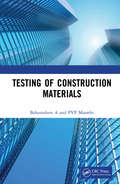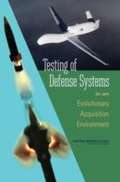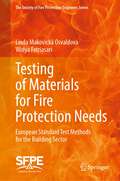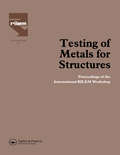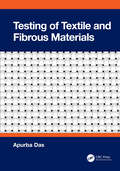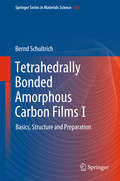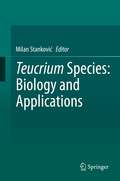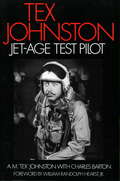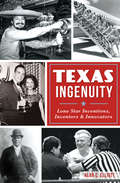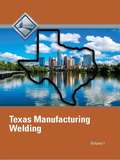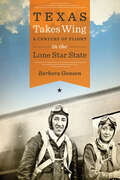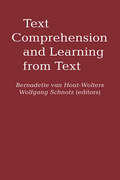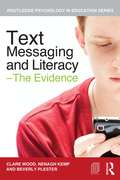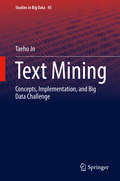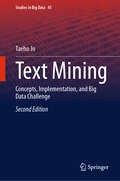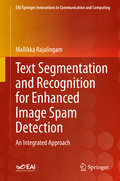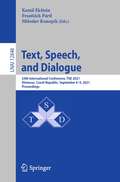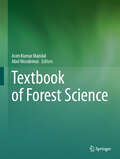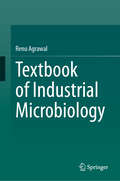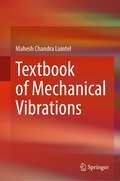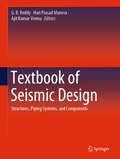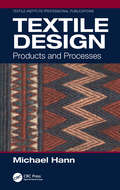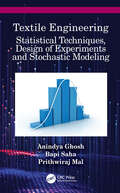- Table View
- List View
Testing of Construction Materials
by Bahurudeen A P.V.P. MoorthiThis book provides an understanding of peer-reviewed international construction materials and their testing methods in a simplified manner at a high technical level. It focuses on specific construction materials, such as cement, concrete, bricks, lime, paints, steel and so forth, distributed in ten different chapters. Using real-time quality control as the underlying determinant, the book material exclusively follows Indian, American, European, German and South African standards. Relevant modern sophisticated material testing techniques, like scanning electron microscope (SEM), thermo gravimetric analysis (TGA) and X-Ray diffraction (XRD), are also described. Aimed at undergraduate, senior undergraduate and early career professionals in civil engineering and construction engineering, this book Gives a clear background of material testing and its importance Includes step-by-step procedures for easy understanding of and for performing the tests Covers Indian, ASTM, South African, DIN German and European Standards Includes basic and advanced techniques for chemical admixtures Each chapter concludes with practice questions, including 400+ solved questions and 50+ test procedures in total
Testing of Defense Systems in an Evolutionary Acquisition Environment
by National Research Council of the National AcademiesThe National Academies Press (NAP)--publisher for the National Academies--publishes more than 200 books a year offering the most authoritative views, definitive information, and groundbreaking recommendations on a wide range of topics in science, engineering, and health. Our books are unique in that they are authored by the nation's leading experts in every scientific field.
Testing of Materials for Fire Protection Needs: European Standard Test Methods for the Building Sector (The Society of Fire Protection Engineers Series)
by Linda Makovická Osvaldová Widya FatriasariThis book offers an overview of European testing methods for fire protection materials.Used in a broad range of applications, these materials are designed to ensure that fires do not occur, or that their effects are combated to the greatest extent possible. The book deals with methods not only for the construction industry but also, for example, for furniture / interior furnishings, plastics, and clothing, including special-purpose clothing for firefighters and rescuers, explosive mixtures, the intensity of smoke, etc. This comprehensive book examines standardized testing methods, while also assessing large-scale tests and specialized non-standardized tests and providing information on various materials and their behavior when exposed to flame.
Testing of Metals for Structures: Proceedings of the International RILEM Workshop
by F. M. MazzolaniThere is a pressing need for rationalization and standardization of test procedures for metals for use in all types of structure. This book brings together the latest international research developments, presented at a RILEM workshop held in Naples in May 1990.
Testing of Textile and Fibrous Materials
by Apurba DasThis book contains detailed knowledge about testing principles of fibre, yarn, and fabric characteristics, the tensile characteristics of materials and testing of fibrous-composites and technical textiles. It starts with an introduction to textile testing and further covers moisture in relation to textile materials, sampling techniques for textile materials and the basic applied statistics, fibre characteristics, fibre length, cotton fibre fineness and maturity characteristics. It also deals with the advanced characterisation of cotton fibre by using HVI and AFIS systems.Features: It covers the principles of the testing of textile and fibrous materials along with modern techniques for testing textile materials It reviews all necessary topics related to fibre, yarn, fabric, technical textiles, and composite testing It explores the tensile characteristics of textile materials and measurement principles It discusses low-stress mechanical characteristics and transmission characteristics It includes a large number of examples and exercises based on actual industrial conditions worldwide including solutions This textbook is aimed at senior undergraduate students in textile testing and evaluation of textile materials.
Tetrahedrally Bonded Amorphous Carbon Films I
by Bernd SchultrichThis book presents the status quo of the structure, preparation, properties and applications of tetrahedrally bonded amorphous carbon (ta-C) films and compares them with related film systems. Tetrahedrally bonded amorphous carbon films (ta-C) combine some of the outstanding properties of diamond with the versatility of amorphous materials. The book compares experimental results with the predictions of theoretical analyses, condensing them to practicable rules. It is strictly application oriented, emphasizing the exceptional potential of ta-C for tribological coatings of tools and components.
Teucrium Species: Biology and Applications
by Milan StankovićTeucrium species are an intersting object of research in the various aspects of science with multiple applications. With more than 300 species, Teucrium is one of the largest and well distributed genera of the Lamiaceae family. Known medicinal Teucrium species have a long traditional use as well as different potential applications in pharmacy, food and beverage industry. Teucrium species are very rich in a variety of secondary metabolites with significant biological activities. Based on that, the book contains 15 chapters which discusses recent advances in exploring the unique features of Teucrium species including morphology, systematics, taxonomy, biogeography, ethnobotany, phytochemistry, biological activity such as genotoxic, antioxidant, antibacterial, antifungal, antiviral, anticancer, anticholinesterase, antidiabetic and anti-inflammatory activity of secondary metabolites as well as applications including current challenges and further perspectives. Some medicinal Teucrium species in excessive use can cause certain consequences. This phenomenon and precaution is also described. Whilst this book is primarily aimed at scientists, researchers, beginners in the investigations of Teucrium species, graduate and post-graduate students in biology, botany, biotechnology, agriculture, and pharmacy, as well as science enthusiasts and practitioners involved in medicinal plants applications. Book provides complete Teucrium species list, color photographs of selected Teucrium species on natural habitats, as well as up-to-date bibliography related to Teucrium genus.
Tex Johnston
by A. M. JohnstonOne of America's most daring and accomplished test pilots, Tex Johnston flew the first US jet airplanes and, in a career spanning the 1930s through the 1970s, helped create the jet age at such pioneering aersospace companies as Bell Aircraft and Boeing.
Texas Ingenuity: Lone Star Inventions, Inventors & Innovators
by Alan C. ElliottImagination is bigger in Texas, too. This collection of inspiring and often quirky stories highlights dozens of examples of innovation from Lone Star history. The Hamill brothers devised a better oil well to reach gushers at Spindletop. The first Neiman-Marcus store opened in Dallas in 1907, revolutionizing the retail fashion world. Astroturf emerged at the Astrodome in 1966. Fritos and corn dogs are just two ubiquitous snack foods claimed as Texan originals. Houston native, and civil rights activist, Congresswoman Barbara Jordan rose to national prominence as a voice of unity during the Watergate scandal. Author Alan C. Elliott details these and many more lessons in success in Texas Ingenuity.
Texas Shipwrecks (Images of America)
by Mark LardasThe Texas coastline and offshore waters are flat, shallow, featureless, and filled with shoals. Texas waters are subjected to extreme weather, not just hurricanes and tropical storms but also northers and seasonal gales. This, combined with two centuries of naval warfare off Texas waters, produced many shipwrecks of all sorts, from Spanish treasure fleets to simple working boats. The ships of pirates, navies, cotton traders, immigrants, fishermen, and oil shippers line the Texas coast, cover the sea bottom off Texas, and blanket the bottom of Texas rivers. Each wreck has a story, romantic or repellent, prosaic or unusual, but all intriguing.
Texas Takes Wing: A Century of Flight in the Lone Star State (Bridwell Texas History Series)
by Barbara GansonA history of aviation in Texas that &“brilliantly demonstrates the evolution of flight technology as a harbinger of social change&” (Technology and Culture). In this book, pilot and historian Barbara Ganson brings to life the colorful personalities that shaped the phenomenally successful development of the aviation industry in the Lone Star state. Weaving stories and profiles of aviators, designers, manufacturers, and those in related services, Texas Takes Wing covers the major trends that propelled Texas to the forefront of the field. Covering institutions from San Antonio&’s Randolph Air Force Base (the West Point of this branch of service) to Brownsville&’s airport with its Pan American Airlines instrument flight school (which served as an international gateway to Latin America as early as the 1920s) to Houston&’s Johnson Space Center, home of Mission Control for the US space program, the book provides an exhilarating timeline and engaging history of dozens of unsung pioneers as well as their more widely celebrated peers. Drawn from personal interviews as well as major archives and the collections of several commercial airlines, including American, Southwest, Braniff, Pan American Airways, and Continental, this sweeping history captures the story of powered flight in Texas since 1910. With its generally favorable flying weather, flat terrain, and wide-open spaces, Texas has more airports than any other state and is often considered one of America&’s most aviation-friendly places. Texas Takes Wing also explores the men and women who made the region pivotal in military training, aircraft manufacturing during wartime, general aviation, and air servicing of the agricultural industry. The result is a soaring history that will delight aviators and passengers alike. Includes photos
Text Comprehension And Learning
by Wolfgang Schnotz Bernadette Van Hout-WoltersThis book deals with the significance of different text structures and its cognitive processing in learning from texts. It discusses the effect of learning abilities and attitudes for learning from texts, and focuses on the significance of processing and learning strategies for text comprehension.
Text Messaging and Literacy – The Evidence
by Clare Wood Nenagh Kemp Beverly Plester"Well thought out and timely. This is the leading group in the world working on texting and literacy, and they have a strong track record of publications. It would also be the first book, as they say, to deal with the subject at an academic level. The focus on education is important, as this is where most of the anxieties lie. It will be a major step forward in creating a new climate." Professor David Crystal, author of The Cambridge Encyclopaedia of Language and The Cambridge Encyclopaedia of the English Language, Television consultant and presenter As children are given mobile phones at increasingly younger ages, there is considerable media coverage of claims that mobile phones, and text messaging in particular, are responsible for declining levels of literacy in children and young people. Such claims are often adopted wholesale by teachers and parents, despite the fact that there is an empirical literature which has failed to find a basis to these claims, and to the contrary has found that text messaging is supporting children’s literacy skills. Written by leading international researchers Text Messaging and Literacy presents an overview and discussion of the academic evidence for and against use of text messaging and mobile phones in supporting literate activity and discusses what conclusions we can and should draw about the impact of mobile phones, and their potential role in education. Areas covered include: the rise of texting and media reactions; children’s reading, spelling and texting; text messaging of children with language difficulties; using mobile phones for literacy development; texting and literacy skills in adolescents and adults; spelling and grammar in texting and beyond; the future of texting. In challenging existing assumptions the authors present the cutting edge of international research, highlighting their own studies involving children of all ages, adolescents and adults. This ground breaking book is essential reading for both researchers and students in education, educational psychology, literacy and new media and it’s impact on learning.
Text Mining: Concepts, Implementation, and Big Data Challenge (Studies in Big Data #45)
by Taeho JoThis book discusses text mining and different ways this type of data mining can be used to find implicit knowledge from text collections. The author provides the guidelines for implementing text mining systems in Java, as well as concepts and approaches. The book starts by providing detailed text preprocessing techniques and then goes on to provide concepts, the techniques, the implementation, and the evaluation of text categorization. It then goes into more advanced topics including text summarization, text segmentation, topic mapping, and automatic text management.
Text Mining: Concepts, Implementation, and Big Data Challenge (Studies in Big Data #45)
by Taeho JoThis popular book, updated as a textbook for classroom use, discusses text mining and different ways this type of data mining can be used to find implicit knowledge from text collections. The author provides the guidelines for implementing text mining systems in Java, as well as concepts and approaches. The book starts by providing detailed text preprocessing techniques and then goes on to provide concepts, the techniques, the implementation, and the evaluation of text categorization. It then goes into more advanced topics including text summarization, text segmentation, topic mapping, and automatic text management. The book features exercises and code to help readers quickly learn and apply knowledge.
Text Segmentation and Recognition for Enhanced Image Spam Detection: An Integrated Approach (EAI/Springer Innovations in Communication and Computing)
by Mallikka RajalingamThis book discusses email spam detection and its challenges such as text classification and categorization. The book proposes an efficient spam detection technique that is a combination of Character Segmentation and Recognition and Classification (CSRC). The author describes how this can detect whether an email (text and image based) is a spam mail or not. The book presents four solutions: first, to extract the text character from the image by segmentation process which includes a combination of Discrete Wavelet Transform (DWT) and skew detection. Second, text characters are via text recognition and visual feature extraction approach which relies on contour analysis with improved Local Binary Pattern (LBP). Third, extracted text features are classified using improvised K-Nearest Neighbor search (KNN) and Support Vector Machine (SVM). Fourth, the performance of the proposed method is validated by the measure of metric named as sensitivity, specificity, precision, recall, F-measure, accuracy, error rate and correct rate. Presents solutions to email spam detection and discusses its challenges such as text classification and categorization;Analyzes the proposed techniques’ performance using precision, F-measure, recall and accuracy;Evaluates the limitations of the proposed research thereby recommending future research.
Text, Speech, and Dialogue: 24th International Conference, TSD 2021, Olomouc, Czech Republic, September 6–9, 2021, Proceedings (Lecture Notes in Computer Science #12848)
by Kamil Ekštein František Pártl Miloslav KonopíkThis book constitutes the proceedings of the 24th International Conference on Text, Speech, and Dialogue, TSD 2021, held in Olomouc, Czech Republic, in September 2021.*The 2 keynote speeches and 46 papers presented in this volume were carefully reviewed and selected from 101 submissions. The topical sections "Text", "Speech", and "Dialogue" deal with the following issues: speech recognition; corpora and language resources; speech and spoken language generation; tagging, classification and parsing of text and speech; semantic processing of text and speech; integrating applications of text and speech processing; automatic dialogue systems; multimodal techniques and modelling, and others. * Due to the COVID-19 pandemic the conference was held in a "hybrid" mode.
Textbook of Forest Science
by Asim Kumar Mandal Abel NicodemusThis textbook presents the latest knowledge on various disciplines of forestry science presented in 39 chapters. Each chapter presents a reappraisal of theory and practice, applications and future scope of subject area. It is a single point reference for updated information on both traditional and contemporary areas of forestry. Some of the disciplines covered in the book are biotechnology, remote sensing, forest certification, forest management, forest hydrology, climate change, plantation and urban forestry, biodiversity and genetic resources conservation, wildfire science, seed science and quality seed production and ecosystem services. The book primarily serves as an advanced textbook of forest science for students of forestry at all levels. The science of forestry is receiving much more attention of the researchers, policy makers, andl public than ever before because of growing awareness of vital importance of forests in amelioration of world environment. This book is a comprehensive collection of existing and new methods including outcome and future possibilities of forest science. This book benefits undergraduate and postgraduate students, professional researchers, teachers, practicing foresters, and policy planners. The book also encourages the public to understand the relevance of forest science to overcome the contemporary economic and environmental challenges.
Textbook of Industrial Microbiology
by Renu AgrawalTextbook of Industrial Microbiology is a groundbreaking book encompassing the entire spectrum of industrial microbiology, filling a significant void in the field. From tracing its historical roots to exploring primary and secondary metabolites, down to downstream processing and product recovery, this book offers a cohesive narrative previously unavailable in a single resource. The meticulously structured chapters discuss the systematic journey of metabolites, covering the screening of microorganisms, preservation techniques, fermentation media, fermenters, and the significance of industrially vital secondary metabolites. It provides insights for industrialists, elucidating crucial process parameters essential for comprehending and optimizing microbial processes. This textbook serves as a great resource for undergraduate, and postgraduate students, researchers, industrialists, and technologists
Textbook of Mechanical Vibrations
by Mahesh Chandra LuintelThis textbook covers the fundamentals and applications of mechanical vibrations and is useful for both undergraduate and postgraduate courses. It provides a concise and clear presentation of dynamics and vibrations including many examples to provide instant illustration and applications of the mathematical relations obtained. It contains self-explanatory sketches, graphs, and figures to curtail long text. Numerous illustrated examples, exercises, and problems at the end of each chapter serve as good sources to grasp the basic principles presented in the text. Review questions and sufficient problems have also been included at the end of each chapter with answer keys for self evaluation. This textbook can also be used as a reference book by researchers and professionals interested in vibrations.
Textbook of Seismic Design: Structures, Piping Systems, and Components
by Ajit Kumar Verma Hari Prasad Muruva G. R. ReddyThis book focuses on the seismic design of Structures, Piping Systems and Components (SSC). It explains the basic mechanisms of earthquakes, generation of design basis ground motion, and fundamentals of structural dynamics; further, it delves into geotechnical aspects related to the earthquake design, analysis of multi degree-of-freedom systems, and seismic design of RC structures and steel structures. The book discusses the design of components and piping systems located at the ground level as well as at different floor levels of the structure. It also covers anchorage design of component and piping system, and provides an introduction to retrofitting, seismic response control including seismic base isolation, and testing of SSCs. The book is written in an easy-to-understand way, with review questions, case studies and detailed examples on each topic. This educational approach makes the book useful in both classrooms and professional training courses for students, researchers, and professionals alike.
Textbook on Cloning, Expression and Purification of Recombinant Proteins
by Kakoli BoseThis book is immensely useful for graduate students as well as researchers to understand the basics of molecular biology and Recombinant DNA Technology. It provides a comprehensive overview of different approaches for the synthesis of recombinant proteins from E. coli including their cloning, expression and purification. Recent advances in genomics, proteomics, and bioinformatics have facilitated the use of Recombinant DNA Technology for evaluating the biophysical and biochemical properties of various proteins. The book starts with an introductory chapter on gene cloning, protein expression and purification and its implication in current research and commercial applications. Each chapter provides a lucid set of principles, tools and techniques for both students and instructors. The protocols described have been aptly exemplified, and troubleshooting techniques have been included to aid better understanding. Moreover, the set of questions at the end of each chapter have been particularly formulated to help effective learning.
Textile Design: Products and Processes (Textile Institute Professional Publications)
by Michael HannThis book includes fundamentals of textile processing technology with explanation of craft techniques, various stages of processing fibres and yarns with useful, readily understandable, line drawings. Fibrous types, dyes, yarns and cloths have been explained and material is supported by glossary and explanation of processing stages from fibre to finished cloth. Further, the considerations of relevance to the development and preparation of a design collection are outlined and discussed. Various testing procedures, including fibre, yarn and cloth identification methods, and important innovations in textile products and processing are identified and explained as well. Focused mainly on the needs of students specializing in textile or fashion design, at first year undergraduate university level, this book: Covers all stages from fibre to finished cloth. Discusses various stages of processing fibres and yarns. Explains fibrous types, dyes, yarns and cloths supported by relevant glossary. Presents explanations of both tactile and aesthetic aspects of textiles used in clothing.
Textile Engineering: Statistical Techniques, Design of Experiments and Stochastic Modeling
by Anindya Ghosh Prithwiraj Mal Bapi SahaFocusing on the importance of the application of statistical techniques, this book covers the design of experiments and stochastic modeling in textile engineering. Textile Engineering: Statistical Techniques, Design of Experiments and Stochastic Modeling focuses on the analysis and interpretation of textile data for improving the quality of textile processes and products using various statistical techniques. FEATURES Explores probability, random variables, probability distribution, estimation, significance test, ANOVA, acceptance sampling, control chart, regression and correlation, design of experiments and stochastic modeling pertaining to textiles Presents step-by-step mathematical derivations Includes MATLAB® codes for solving various numerical problems Consists of case studies, practical examples and homework problems in each chapter This book is aimed at graduate students, researchers and professionals in textile engineering, textile clothing, textile management and industrial engineering. This book is equally useful for learners and practitioners in other science and technological domains.
